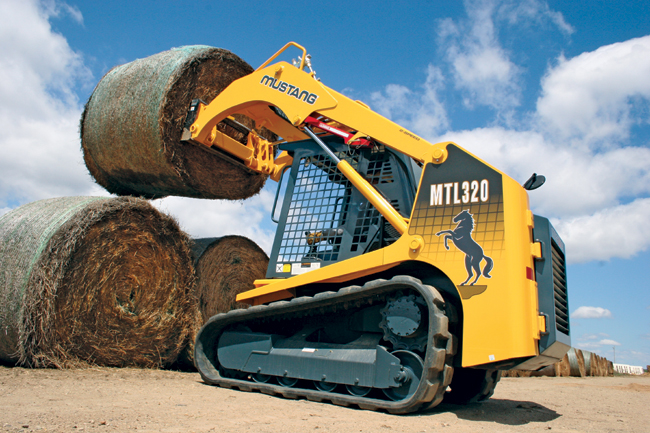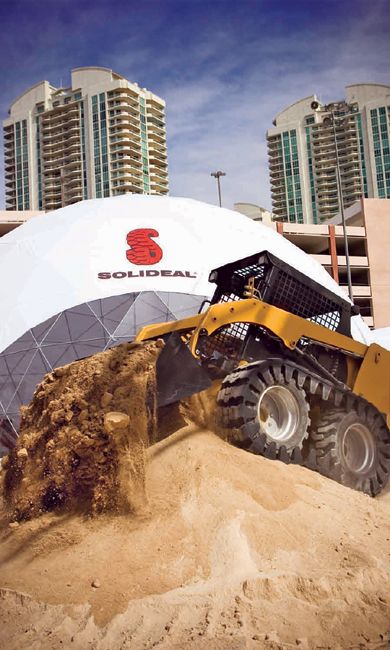Professional Trackers
So you’ve finally decided to pull the trigger and purchase a new compact track loader. Congrats. You will, without question, experience a longer working season, more pushing power and the ability to work without the fear of digging tire ruts in someone’s well manicured backyard. Looks like a sound business decision: more jobs available to you; more opportunities to get your name out there; and most importantly, more income for the business.
 |
| Skid steer or track loader? That is the question. If you are equipped with a tire and a track machine, consider the application and decide which machine can best complete the job with the least amount of wear and tear on the piece of equipment. |
But wait, this sounds too good to be true … can it be? With all good things, there are limitations. Compact track loaders (CTLs) have limitations too, particularly when it comes to rubber tracks. Consider a skid steer vs. a compact track loader. The average cost to change a set of four 12- by 16.5-in. tires for a larger chassis skid steer is around $800; a little more if you get a specialty tire or a little less if you purchase on the lower end. A set of rubber tracks for a similar size machine will cost you around $2,100. Again, a little more money if you choose an OEM brand or a little less if you buy at the lower end. That’s a difference of $1,300 to replace your most wearable part — rubber.
Something else to think about is when you blow a tire on a jobsite, you can patch it and be up and running in no time. Bust a rubber track on a jobsite and you’re down a few days waiting for a new one to arrive. Just so we’re clear, repairing a track is not a long-term, viable option — unless you know something we don’t.
So how do you win? How do you retain all additional income your new CTL machine will bring without spending its profits on expensive rubber tracks or costly undercarriage components? Well, it’s not a sure-fire way of avoiding these costs, but if you follow a few general rules, you can keep more money for your business.
Know Your Jobsite
When bidding on new contracts, factor in the expected undercarriage costs of the job environment you will be working on. While there is no exact formula to use when calculating this, consider the difference between working on landscaping jobs vs. road building. The wear characteristics are vastly different (concrete/asphalt vs. grass/dirt) and you should expect a faster wear rate on harsh applications.
Know What Machine Is Best Suited for the Job
This seems like a no brainer, but it’s often overlooked. As a rubber track product manager, I can’t tell you how many times I have visited quarry applications where the owner of his CTL machine was frustrated that his tracks were not lasting any longer than 200 hours. It’s a miracle he even got 200 hours out of them. In my opinion, the only piece of equipment that should have been working in that quarry is a wheeled skid steer machine with solid rubber tires. If you are equipped with a tire and a track machine, consider the application and decide which machine can best complete the job with the least amount of wear and tear on the piece of equipment. If you choose the track machine as the best machine for a harsh job application, understand the additional cost and bid accordingly.
Sprockets and Other Wearable Items
It’s steel right, how can it wear? The answer is very easily. Most sprockets, rollers and idler wheels are given a hardness treatment before assembly that protects it from a few millimeters of wear. Once you wear past the hardness coating, your rollers and sprockets begin to wear very rapidly. You wouldn’t think about it, but once you see new OEM parts laying beside your worn parts, you can quickly and easily see how much these components wear. When you replace your old rubber track with a new one without updating your wearable components, you potentially risk premature wear on the track. Why, you ask? It worked perfectly well on the current undercarriage, right? Why do I need to invest in my sprockets and roller wheels? Simple: New components that wear together tend to last much longer than a new part and a worn part matched together.
Understand that Operator Errors Happen — Plan for It!
If I have heard it once, I’ve heard it a thousand times: “My operators are well trained and experienced. They couldn’t have caused this damage to the track. Your track failed.” OK, I’m not going to get into a debate with contractors over the telephone about their operators. However let’s be honest, mistakes happen. They run over a sharp piece of rebar, hit a curb, run over an oblong rock or simply hit something that causes damage to the track. This is not a rubber track manufacturing defect; it’s the result of application damage or environment hazard. Think about it in terms of tires for your car or truck. When you get a nail or screw in the tire and it goes flat, ask yourself: “Is this a tire defect or a road hazard?” When planning and bidding for jobs, keep this expense in mind. It’s nearly impossible to know when it will happen, but it will. Be prepared for it.
 |
| Solideal is a complete track solutions provider. Sure it makes aftermarket tracks for compact track loaders, but did you know it also manufactures over-the-tire tracks for skid steers? |
Your Dealer’s the Best on Earth, but They Can Be Biased
When you choose an alternative aftermarket part for your machine (either a track or an oil filter) you take away another opportunity for your servicing dealer to invoice you. They may never say it, but it frustrates them. When you bring your compact track loader into the dealer’s shop for preventive maintenance from time to time, don’t be surprised if you hear negative things about aftermarket parts you didn’t purchase from them. This will range from:
- “This aftermarket track is causing damage and excessive wear to your drive system.”
- “Because of this aftermarket part, we now need to rebuild your entire undercarriage.”
- “Oh, where did you get this track from … didn’t you know we were running a special last month … buy one, get one free?”
Maybe one or two of those are embellished, but you get the point. Take these comments with a grain of salt and move on. It’s no use arguing with someone who has the brand name of your machine on their shirt. Bottom line is this: When moving into the world of compact track loaders, educate and prepare yourself as thoroughly as possible. The unexpected always happens and the more foresight you have, the better prepared you will be to absorb these costs and put more toward the company’s bottom line.
Jared Steier is the rubber track product manager for Solideal USA, based in Charlotte, N.C. Steier has spent the last five years in the field learning, selling and developing the rubber track OEM and aftermarket business.





Comments are closed here.